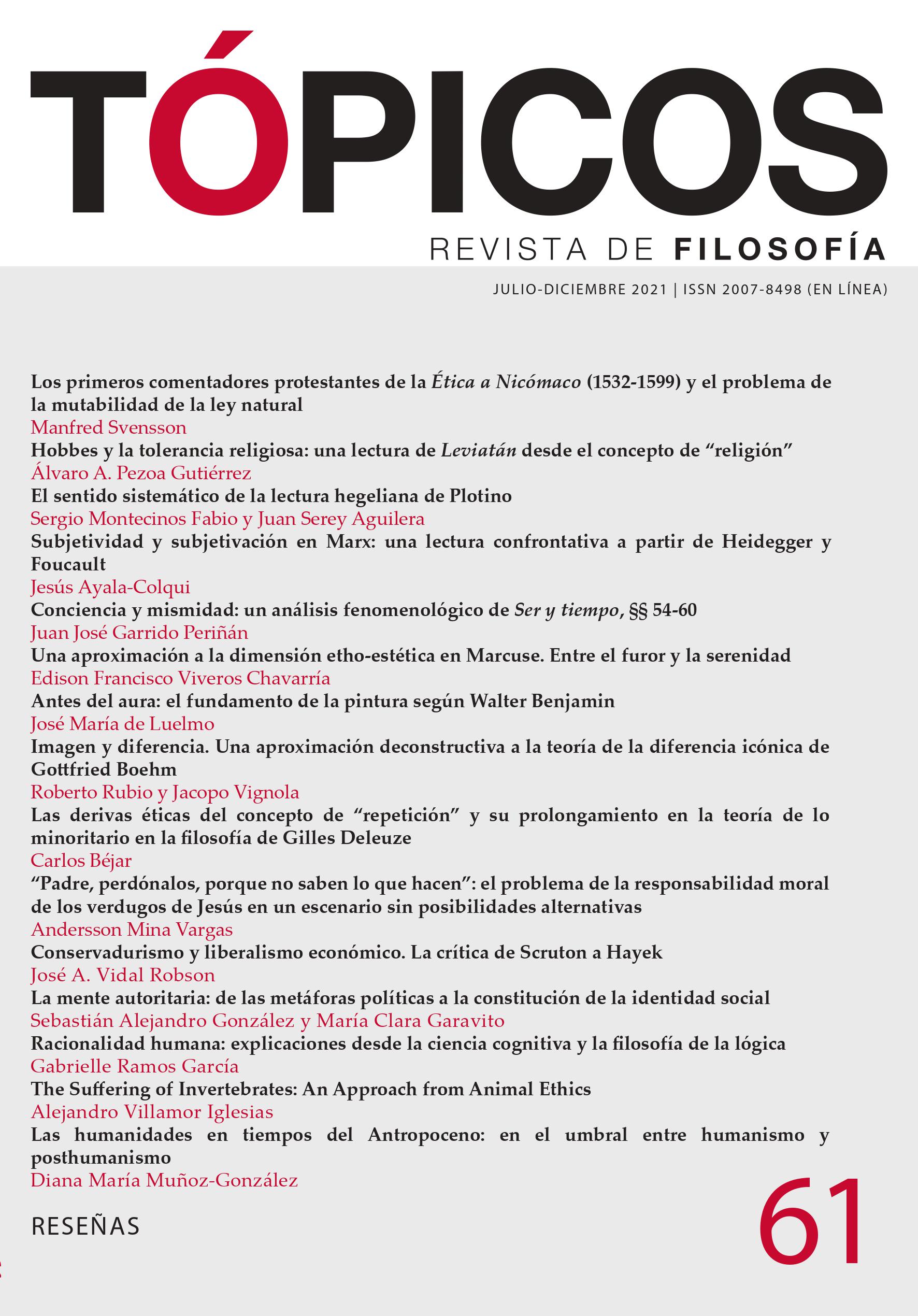Pubblicato 2021-06-23
Parole chiave
- Walter Benjamin,
- pintura,
- lenguaje,
- imagen,
- aura
Copyright (c) 2021 Tópicos, Revista de Filosofía

Questo volume è pubblicato con la licenza Creative Commons Attribuzione - Non commerciale - Non opere derivate 4.0 Internazionale.
Come citare
Abstract
Aunque en su obra tardía Walter Benjamin parece emplear la pintura de manera accesoria —ya como contrafigura aurática, ya como víctima propiciatoria de la imagen técnica—, las alusiones al medio que pautan su trayectoria evidencian la importancia que posee en el conjunto de su reflexión estética e incluso en la configuración de su teoría del lenguaje. De especial relevancia para fijar la cuestión es el ensayo inédito de juventud “Sobre la pintura, o: el signo y la mancha”, donde se establecen los rasgos generales de su idea de la pintura, pero también otros escritos del mismo periodo que, aun abordando tangencialmente la materia, la modelan en mayor o menor grado y determinan su alcance general.
Riferimenti bibliografici
- Benjamin, A. (2009). Framing Pictures, Transcending Marks: Walter Benjamin’s Paintings, or Signs and Marks. En A. Benjamin y C. Rice (eds.), Walter Benjamin and the Architecture of Modernity. (pp. 229-243). Re-press.
- Benjamin, W. (1974). Haschisch. J. Aguirre (trad.). Taurus.
- Benjamin, W. (1977). Ammerkungen der Herausgeber. En Gesammelte Schriften. Zweiter Band. Dritter Teil. (pp. 1412-1415). Suhrkamp.
- Benjamin, W. (1978). Briefe. I. G. Scholem y T. W. Adorno (eds.). Suhrkamp.
- Benjamin, W. (1991). Gesammelte Schriften. Band VI. R. Tiedemann y H. Schweppenhäuser (eds.). Suhrkamp.
- Benjamin, W. (1997). La dialéctica en suspenso. Fragmentos sobre la historia. P. Oyarzún (trad.). ARCIS-LOM.
- Benjamin, W. (2005). Libro de los Pasajes. L. Fernández, I. Herrera y F. Guerrero (trads.). Akal.
- Benjamin, W. (2006a). El concepto de crítica de arte en el Romanticismo alemán. En Obras. Libro I. Vol. 1. (pp. 7-122). A. Brotons (trad.). Abada.
- Benjamin, W. (2006b). Walter Benjamins Archive. Bilder, Texte und Zeichen. Suhrkamp.
- Benjamin, W. (2007a). Hacia la crítica de la violencia. En Obras. Libro II. Vol. 1. (pp. 183-206). J. Navarro (trad.). Abada.
- Benjamin, W. (2007b). Sobre el lenguaje en cuanto tal y sobre el lenguaje del hombre. Obras. Libro II. Vol. 1. (pp. 144-162). J. Navarro (trad.). Abada.
- Benjamin, W. (2007c). Sobre la facultad mimética. Obras. Libro II. Vol. 1. (pp. 213-216). J. Navarro (trad.). Abada.
- Benjamin, W. (2008). La obra de arte en la época de su reproductibilidad técnica. En Obras. Libro I. Vol. 2. (pp. 11-85). A. Brotons (trad.). Abada.
- Benjamin, W. (2009a). Pintura y dibujo. Obras. Libro II. Vol. 2. (p. 211). J. Navarro (trad.). Abada.
- Benjamin, W. (2009b). Sobre la pintura, o: el signo y la mancha. Obras. Libro II. Vol. 2. (pp. 212-216). J. Navarro (trad.). Abada.
- Benjamin, W. (2010a). Calle de dirección única. Obras. Libro IV. Vol. 1. (pp. 23-89). J. Navarro (trad.). Abada.
- Benjamin, W. (2010b). Infancia en Berlín hacia el mil novecientos. Obras. Libro IV. Vol. 1. (pp. 177-247). J. Navarro (trad.). Abada.
- Benjamin, W. (2017). Sobre la estética (1919-36). Obras. Libro VI. (pp. 141-167). A. Brotons (trad.). Abada.
- Bois, Y.-A. (1990). Painting as Model. MIT Press.
- Bruno, G. (1989). Expulsión de la bestia triunfante. M. A. Granada (trad.). Alianza.
- Bulthaup, P. (1975). Materialen zu Benjamins Über den Begriff der Geschichte. Beitrage und Interpretationen. Suhrkamp.
- Cheng, F. (2004). Vacío y plenitud. El lenguaje de la pintura china. A. Hernández y J. L. Delmont (trads.). Siruela.
- Cixous, H. (2010). Poetas en pintura. J. Bassas y J. Masó (trads.). Ellago.
- Deleuze, G. (2007). Pintura. El concepto de diagrama. Cactus.
- De Luelmo, J. M. (2014). Carl Einstein y el umbral heurístico de la pintura. Daimon. Revista Internacional de Filosofía, 61, 23-37.
- Benjamin, W. (2018). Desvelar lo visible. Merleau-Ponty y el aprendizaje por la pintura. Arte, Individuo y Sociedad, 1(30), 29-41.
- Einstein, C. y Kahnweiler, D.-H. (1993). Correspondance. 1921-1939. André Dimanche.
- Eggelhöfer, F. y Keller, M. (2013). Teoría de la configuración pictórica. En F. Eggelhöfer y M. Keller (eds.), Paul Klee. Maestro de la Bauhaus. Fundación Juan March.
- Gelhard, D. (2014). Ist die Kultur erwacht? Benjamin und die Malerei. Passagen.
- Jennings, M. (1987). Dialectical Images. Walter Benjamin’s Theory of Literary Criticism. Cornell University Press.
- Jullien, F. (2008). La gran imagen no tiene forma, o: del no-objeto por la pintura. A. Galvany (trad.). Alpha Decay.
- Kandinsky, W. (1979). De lo espiritual en el arte. E. Palma (trad.). Premià.
- Kobry, Y. (1990). Walter Benjamin et le langage. Revue d’esthétique, número especial, 175-180.
- Lindner, B. (2014). Alegoría. En M. Opitz y E. Wizisla (eds.), Conceptos de Walter Benjamin. (pp. 17-82). M. Belforte y M. Vedda (trads). Las cuarenta.
- Löwy, M. (2003). Walter Benjamin. Aviso de incendio. H. Pons (trad.). Fondo de Cultura Económica.
- Scholem, G. (1987). Walter Benjamin. Historia de una amistad. V. Jarque (trad.). Península.
- Scholem, G. (2000). Tagebücher: nebst Aufsätzen und Entwürfen bis 1923. Volumen 2. Jüdischer Verlag.
- Scholem, G. (2003). Walter Benjamin y su ángel. R. Ibarlucía y L. Carugati (trads.). Fondo de Cultura Económica.
- Von Goethe, J. W. (2008). Johann Wolfgang von Goethe. Paisajes. Círculo de Bellas Artes.
- Weigel, S. (1999). Cuerpo, imagen y espacio en Walter Benjamin. Una relectura. J. Amícola (trad.). Paidós.






